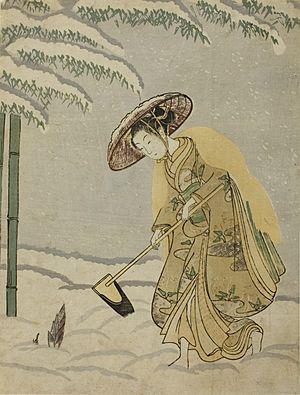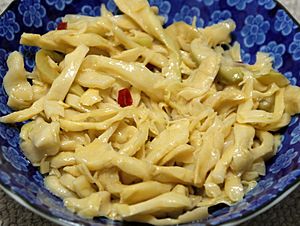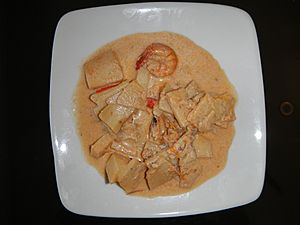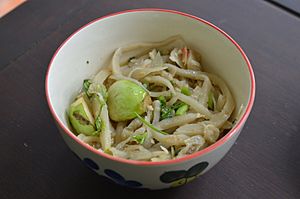Bamboo shoot facts for kids
Quick facts for kids Bamboo shoot |
|||||||||||||||
|---|---|---|---|---|---|---|---|---|---|---|---|---|---|---|---|
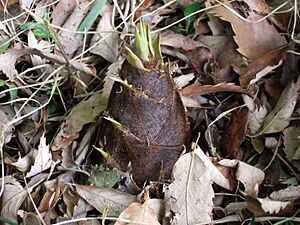
Tasty bamboo shoots
|
|||||||||||||||
| Chinese name | |||||||||||||||
| Traditional Chinese | 竹筍 | ||||||||||||||
| Simplified Chinese | 竹笋 | ||||||||||||||
|
|||||||||||||||
| Korean name | |||||||||||||||
| Hangul | 죽순, 대나무싹 | ||||||||||||||
|
|||||||||||||||
| Japanese name | |||||||||||||||
| Kanji | 竹の子 or 筍 | ||||||||||||||
| Kana | タケノコ | ||||||||||||||
|
|||||||||||||||
| Nutritional value per 100 g (3.5 oz) | |
|---|---|
| Energy | 115 kJ (27 kcal) |
|
5.2 g
|
|
| Sugars | 3 g |
| Dietary fibre | 2.2 g |
|
0.3 g
|
|
|
Protein
|
2.6 g
|
| Vitamins | Quantity
%DV†
|
| Thiamine (B1) |
13%
0.15 mg |
| Riboflavin (B2) |
6%
0.07 mg |
| Niacin (B3) |
4%
0.6 mg |
| Pantothenic acid (B5) |
3%
0.161 mg |
| Vitamin B6 |
18%
0.24 mg |
| Folate (B9) |
2%
7 μg |
| Vitamin C |
5%
4 mg |
| Vitamin E |
7%
1 mg |
| Minerals | Quantity
%DV†
|
| Iron |
4%
0.5 mg |
| Manganese |
12%
0.262 mg |
| Phosphorus |
8%
59 mg |
| Potassium |
18%
533 mg |
| Zinc |
12%
1.1 mg |
|
Link to USDA Database entry
|
|
| †Percentages estimated using US recommendations for adults. | |
Bamboo shoots are the young, edible parts of bamboo plants that sprout from the ground. They are a popular vegetable in many Asian dishes and soups. You can find them fresh, dried, or canned in stores.
Raw bamboo shoots have natural substances called cyanogenic glycosides. These are mild toxins, similar to those found in cassava. To make them safe to eat, fresh bamboo shoots must be cooked thoroughly, usually by boiling them. The canning process also removes these toxins.
Contents
What Are Bamboo Shoots?
Bamboo shoots are the new stems that grow from the roots of bamboo plants. They are harvested when they are young and tender. Many different types of bamboo produce edible shoots.
Where Do They Grow?
Bamboo grows all over the world, especially in Asia. Many species are harvested for their shoots. These include types of bamboo found in:
- China and Vietnam
- The Philippines and India
- Japan and Korea
- Various parts of Southeast Asia
Some common types of bamboo whose shoots are eaten include Bambusa vulgaris and Phyllostachys edulis.
Nutrients in Bamboo Shoots
Fresh bamboo shoots are good for you! They contain important vitamins like thiamine (Vitamin B1), niacin (Vitamin B3), Vitamin A, Vitamin B6, and Vitamin E. They also have many amino acids, which are the building blocks of protein.
How Are Bamboo Shoots Used?
Bamboo shoots are a versatile ingredient. They are used in many different ways across Asia.
East Asia
In countries like Japan, China, and Taiwan, young shoots from certain bamboo types are very popular. They are known for being crisp and sweet. Older shoots might taste a bit bitter, so they are usually sliced thin and boiled many times.
- In Japan, a common topping for ramen noodles is menma. This is made from pickled bamboo.
- In China, pickled bamboo shoots give a special strong smell to a popular noodle dish called luosifen.
South Asia
Bamboo shoots are a traditional food in many parts of South Asia.
- In Nepal, a well-known dish is tama. This is made from fermented bamboo shoots, often cooked with potatoes and beans.
- In Assam, India, bamboo shoots are called khorisa or bah gaj. They are a key part of local cooking.
- In southern India, especially during the rainy season, bamboo shoots are a special dish. They are soaked in water for days to remove any bitter taste. They can also be made into a pickle.
- In Nagaland, India, fermented bamboo shoots are called bas tenga. They are often cooked with pork, which is a very popular dish there.
- In Manipur, India, fresh shoots are u-soi, and fermented ones are soibum. They are used in many dishes and can be stored for a very long time.
- In Meghalaya, bamboo shoots are used fresh or fermented. They are made into pickles, soups, or curries.
Southeast Asia
Bamboo shoots are a staple food in many Southeast Asian countries.
- In the Philippines, bamboo shoots are called labóng. Two very popular dishes are ginataáng labóng (shoots cooked in coconut milk with chilies) and dinengdeng na labóng (shoots cooked with fish sauce and other vegetables). They are also used in spring rolls or sweet pickles.
- In Thai cuisine, bamboo shoots are called no mai. They are used in stir-fries, soups like tom kha kai, and curries. You can find them fresh or pickled.
- In Vietnamese cuisine, shredded bamboo shoots are used in stir-fried dishes. A famous noodle soup is "Duck and bamboo shoot noodles" (Bún măng vịt).
- In Burma, bamboo shoots are called hmyit. A well-known dish is a sour bamboo shoot curry called hmyit chin hin.
- In Indonesia, thin slices of bamboo shoots are boiled with coconut milk and spices to make gulai rebung. They are also used in mixed vegetable dishes and fried spring rolls.
Gallery
-
Growth in Taiwan regional low elevation flat land thorn bamboo shoots.
See also
 In Spanish: Brotes de bambú para niños
In Spanish: Brotes de bambú para niños


